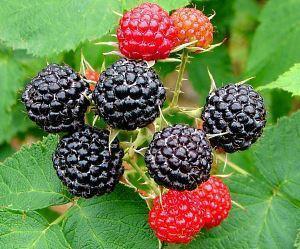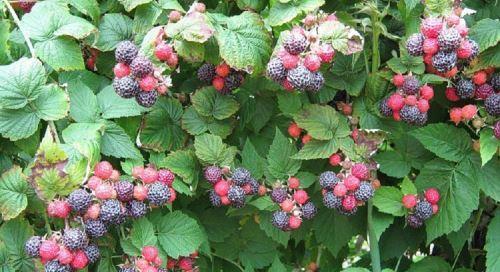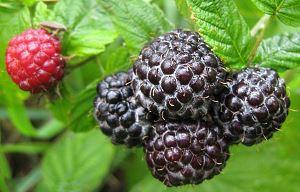Black raspberries - planting and care
 Many summer residents have already heard about black raspberries, and want to know more:
Many summer residents have already heard about black raspberries, and want to know more:
- about her origin,
- about its popular varieties,
- and how to grow this plant.
In this article, those who have experience in growing black raspberries will share their knowledge and secrets. Read also:raspberries remontantnaya - care and cultivation in the suburbs.
Unique culture - black raspberry
What dacha is complete without raspberries? This is an excellent plant. It produces bountiful harvests and heals colds, it is unpretentious and its various varieties differ in taste and even in color. So, for example, black-fruited raspberry in recent years has been deservedly respected by summer residents!
Black raspberry, also called blackberry-like, is a perennial shrub. It belongs to the Rosaceae family. The homeland of the plant is North America. The length of the stems reaches 2-3 m; they are curved and covered with sharp spines.
Features of black raspberry and its differences from red:
- it does not give root growth;
- drought-resistant;
- its fruits, ripening, do not crumble;
- only some varieties of this raspberry tolerate frost well;
- less than red raspberry suffers from pests, and is almost not susceptible to disease;
- does not require special care;
- begins to bear fruit earlier than red;
- the bush has a powerful root system.
The main difference between black raspberries and blackberries is that ripe fruits are easily removed from the stalk.

The advantages of black raspberries
Talk about this berry is not in vain, it really deserves attention. Here are some of the most obvious benefits of this plant:
- Gardeners prefer to grow black raspberries on their plots because of their excellent taste. Black raspberries are much sweeter than regular red ones. And some varieties have a honey taste, without sourness.
- The fact that black raspberries give excellent yields attracts many summer residents. Fragrant berries from a bush can be collected from 2 to 4 or more kilograms, depending on the variety and plant care.
- Elastic berries do not deform during transportation. In addition, raspberries are not only suitable for fresh consumption, but also easily lend themselves to any processing: freezing, canning, making jam.
- The benefits of black raspberries are still being studied, but it is already known that it contains ellagic acid, which not only has the strongest antioxidant activity, but is also an effective means of preventing and combating cancer.
Given this, many summer residents do not hesitate to breed black raspberries in their homes. Now it's worth getting to know the popular varieties of this plant, and find out what kind of care is needed for raspberry bushes.
The most popular varieties of black raspberries with photos
In our area, it is considered the most common variety of Cumberland black raspberries. And this is not surprising, because it perfectly adapted to the climate of our country, and gives excellent harvests. But there are other, no less interesting varieties of black raspberries. For example, Bristal, New Logan, Airlie Cumberland, Litach, Gift of Siberia, Pivot, Coal, Luck, Black Jewel, etc.
Here is a description of some varieties of black raspberries with a photo:
 Litach. This variety began to be developed in Poland in 2008. The early variety bears fruit on two-year-old shoots. The bush is vigorous, with stiff bent shoots and large thorns. The berries are small, spherical in shape with a bluish bloom.
Litach. This variety began to be developed in Poland in 2008. The early variety bears fruit on two-year-old shoots. The bush is vigorous, with stiff bent shoots and large thorns. The berries are small, spherical in shape with a bluish bloom. Coal. Another representative of early maturing varieties. The bush is of medium thickness and spreading.Shoots reach 2.5 m in length, arched with small thorns. The berries are small, juicy, sweet and sour, slightly pubescent. The harvest is good. The plant has a high resistance to diseases and pests, it tolerates frost well.
Coal. Another representative of early maturing varieties. The bush is of medium thickness and spreading.Shoots reach 2.5 m in length, arched with small thorns. The berries are small, juicy, sweet and sour, slightly pubescent. The harvest is good. The plant has a high resistance to diseases and pests, it tolerates frost well. Bristol. Black raspberry, Bristol variety is considered one of the best varieties. Since it gives amazingly high yields. The bush is of medium thickness and shoots 2.5-3 m long. The berries are almost rounded, black with a blue bloom, sweet, juicy. Does not produce root layers, prefers sunny locations and slightly acidic soil. Poorly tolerates cold, susceptible to anthracnose.
Bristol. Black raspberry, Bristol variety is considered one of the best varieties. Since it gives amazingly high yields. The bush is of medium thickness and shoots 2.5-3 m long. The berries are almost rounded, black with a blue bloom, sweet, juicy. Does not produce root layers, prefers sunny locations and slightly acidic soil. Poorly tolerates cold, susceptible to anthracnose. Boysenberry. Early ripe variety. The bush is strong. Shoots reach up to 3 m, no thorns. The berries are oblong, large, shiny, oblong in shape. It tastes sweet. The yield of this variety is high. The plant tolerates winter well, practically does not get sick.
Boysenberry. Early ripe variety. The bush is strong. Shoots reach up to 3 m, no thorns. The berries are oblong, large, shiny, oblong in shape. It tastes sweet. The yield of this variety is high. The plant tolerates winter well, practically does not get sick. New Logan... Early ripe bush. Its height is about 2m. The berries are black, shiny. The yield is large. For the winter, the bush must be covered.
New Logan... Early ripe bush. Its height is about 2m. The berries are black, shiny. The yield is large. For the winter, the bush must be covered. Black raspberry Cumberland... This early-maturing plant is distinguished by a powerful bush that is curved in an arcuate manner. On the shoots there is a wax bloom, there are thorns. The berries are dense, almost round, shiny black. Sweet to taste, with a blackberry flavor. Gives good yields6 about 4 kg per bush. The variety is winter hardy, but does not tolerate an abundance of moisture.
Black raspberry Cumberland... This early-maturing plant is distinguished by a powerful bush that is curved in an arcuate manner. On the shoots there is a wax bloom, there are thorns. The berries are dense, almost round, shiny black. Sweet to taste, with a blackberry flavor. Gives good yields6 about 4 kg per bush. The variety is winter hardy, but does not tolerate an abundance of moisture.
Preparatory work before planting black raspberries
Black raspberries are not demanding, they will grow everywhere, and take root well. But experienced gardeners know for sure that its yield depends entirely on what place the plant will have, on the quality of the soil, and on the care of the fruit bush.
Choosing the right place to plant black raspberries
Things to consider before planting black raspberries:
- A place. A well-lit area is great for growing raspberries. It is also important that there are no drafts: the plant does not tolerate cold winds well.
- Neighbors and predecessors of raspberries on the site. The best neighbor of this plant is the red raspberry. But with its other "relative", blackberries, black raspberries cannot coexist.
Bad predecessors are nightshades: tomato, eggplant, potatoes. It is advisable not to plant raspberries in the same area where these and other crops grew, which suffer from such a fungal disease as verticillary wilting. - Distance between bushes and rows. It is important not to plant black raspberry bushes at close distances, even though they do not produce root shoots. Then there will be no thickening of the plants, each of them will be evenly blown by the wind and warmed up by the sun.
The optimal distance between the bushes is 80 cm; between the rows - about 2 meters. In this case, the plants are easy to care for, and make sure that the branches do not touch the ground.
Suitable soil type for black raspberries
Soil quality is one of the most important factors affecting raspberry yield. Fertile loamy soil is "light" and contains sufficient minerals and nutrients.
Such soil is quite suitable for black raspberries to feel great and bear good fruits, since there is no stagnation of moisture in it, and it retains the heat necessary for the plant, and is breathable.
Planting black raspberries in the country
It is best to plant black raspberries in early spring, given that the vegetation process for this plant begins very early. That is why some summer residents prefer autumn planting. But this is more suitable for an area where winters are not so harsh, since black raspberries do not tolerate the cold period well.
The depth of the planting pit must be at least half a meter; width - 40-50 cm. Wood ash mix with humus 1: 1 and fill a hole of 20-25 centimeters with this composition. After that, it is worth pouring water over the pit. And there carefully, straightening the roots, place a raspberry seedling.Wait until the water is absorbed, and start filling the hole with earth mixed with sand and complex fertilizer... Then water again.
What kind of care is needed?
Even novice summer residents can easily master several rules for caring for black raspberries. This culture does not require special attention, it is enough:
- Mulch the soil;
- Water in time;
- Tie up raspberry branches;
- Learn to conduct correct pruning of the bush;
- Know about diseases and pests of the plant, and be able to protect it;
- Conduct top dressing;
- Prepare raspberries for winter.
Mulching... Immediately after planting the plants, the soil under the bushes is mulched. For this, chopped dry grass or straw, sawdust that pererelya, peat or manure.
Watering... Black raspberries do not require abundant watering even in the summer heat, they tolerate them perfectly. But, when the time for fruit ripening comes, the raspberry bushes must be filled with water in sufficient quantities. Then the berries will be larger, and there will be more of them on the bushes. Of all types of watering, raspberries prefer drip irrigation.
Tying raspberries... The stems of the plant are thin and long, and grow rapidly. Over time, they need a garter. For this, both fences are used, and trellises are installed.
A support such as trellises is very simple to design. To do this, you need to dig in the pillars at the beginning and end of the row of black raspberries. Pull the wire between them in several rows. The stems of the plant are attached to this wire.
Pruning... Pruning is necessary so that the plant does not grow violently, remains healthy, and so that the raspberries give a good harvest. 2 pruning should be done per year. One in the summer, at the end of June, the second in the fall, before the cold weather.
- Summer pruning. It is carried out to increase yields. If you shorten the shoot at the point of growth, then young twigs will grow from this place next year, a kind of fan. It is on these branches that young shoots will present a generous harvest.
- Autumn pruning. This pruning is sanitary, the bush is preparing for winter. Dry and old branches are cut out. Long shoots are shortened.
 Protection against diseases and pests... One of the worst diseases of black raspberries is verticillary wilting. It cannot be cured, therefore prevention is important - the acquisition of healthy plants, the correct planting conditions and refusal to dig the earth near the bush, good drainage of the soil.
Protection against diseases and pests... One of the worst diseases of black raspberries is verticillary wilting. It cannot be cured, therefore prevention is important - the acquisition of healthy plants, the correct planting conditions and refusal to dig the earth near the bush, good drainage of the soil.
A rainy summer or insufficient drainage can lead to fungal infections. To prevent this, you can spray the bushes with preparations containing copper. For prevention, broad-spectrum insecticides are used.
In the fight against the raspberry beetle, which is one of the main pests of black raspberries, spraying with a 2% nitrafen solution is used. This should be done before the kidneys wake up.
When flower buds appear in raspberries, it is necessary to re-spray with infusions of bitter wormwood and marigolds (take 200g of each herb; infuse each of them in 10 liters of water). Before use, the herbal infusions should be mixed, with this solution and sprinkled with raspberries.
Top dressing... Black raspberries always thank you with a bountiful harvest for feeding. It could be organic fertilizersfor example mullein diluted with water 1 in 6 and bird droppings 1 in 17. Plus 1 liter of ash and 50g superphosphate on a bucket of this "drug". Under the bush, top dressing is poured from 5 to 7 liters. Then it is worth pouring water over the entire planting of raspberries.
You can also feed nitrogen mineral fertilizers. They contain the elements necessary for the growth and fruiting of the plant.
Reproduction of black raspberry
Black raspberries are propagated by layering. To do this, at the end of summer, when the branches of black raspberries begin to stretch, they are bent in an arched manner and bent to the ground. It is advisable to pre-dig shallow trenches, 10 cm deep.It is in these trenches that the shoots are lowered, fixed, and covered with earth so that the growing point is above the ground. Preparing for winter, the layers are insulated with sawdust, peat. Rooted layers are separated from the bush in the spring and planted separately.
Preparing black raspberries for winter
 There are several ways to prepare black raspberries for winter. The choice will depend on the climate. Provided that winters are not so severe, you can leave the bushes on the trellis, securely securing each shoot. So neither the wind nor the snow will damage the bushes.
There are several ways to prepare black raspberries for winter. The choice will depend on the climate. Provided that winters are not so severe, you can leave the bushes on the trellis, securely securing each shoot. So neither the wind nor the snow will damage the bushes.
If the winter is long and frosty, you can gently bent the bushes to the ground, but not too low. In this position, fix the raspberry branches. The snow, covering the plants, will save them from the cold.
Black raspberries will become the main crop in the country, and will delight with their bountiful harvests, if you devote a little time and learn about it. Then caring for this plant will not be a hassle.
It grew very much, but I did not know that it turns out that I need to cut it 2 times. Thank.